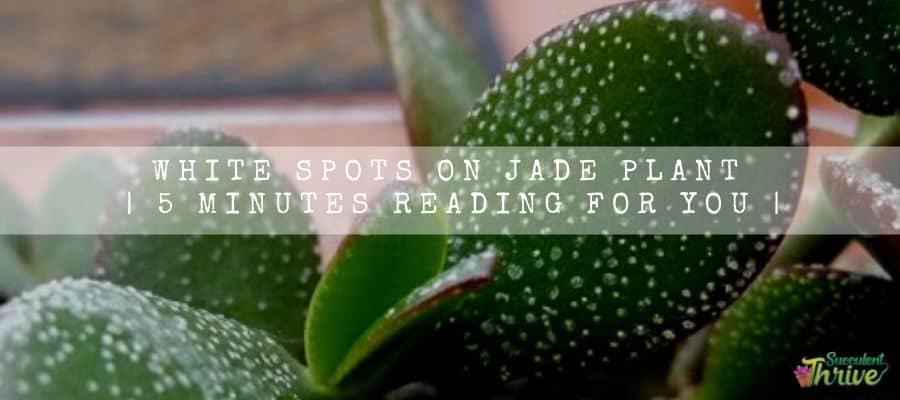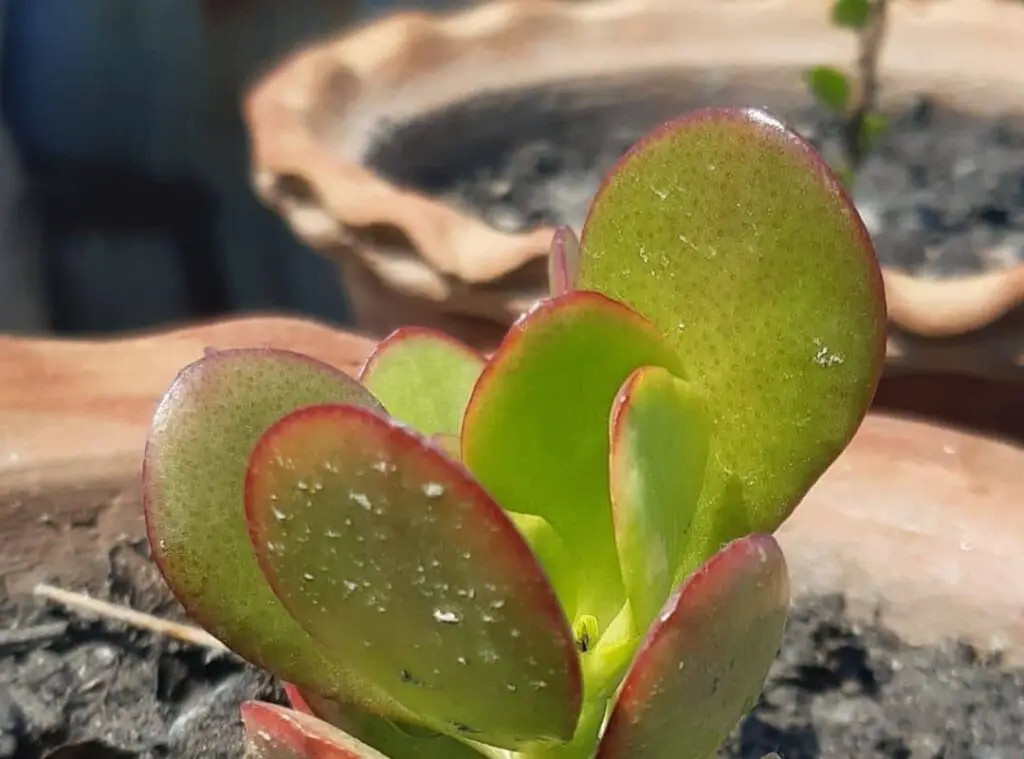Jade plants are classic and quite famous houseplants. However, it is quite common to spot white spots on jade plants even though they have healthy growing conditions. This could be due to several reasons including
- Mineral deposits
- Watering with hardwater
- Powdery mildew
In this article I am going to talk about more details about what causes white spots on Jade plants and how to get rid of them.

What is white spot in a jade plant?
Jade plants would develop white spots as a result of natural causes. Nevertheless, you could easily attend to this issue once they go through this condition. However, if you notice that the plant’s health is satisfactory as a whole and if it has white spots, you could ignore that. The reasons for a Jade plant to form white spots are as follows.
Mineral deposit
It could occur because of the mineral buildup in the compost. Any jade plant that you have grown in a pot is prone to this. The uptake of the nutrients could cause this condition, especially for the plants that you have grown in the pots. As you know, we do not have to repot the succulents more often. As such, the nutrient content of the compost could decrease slowly.
particularly if you have let your plant stay in the same pot for so many years. It could be a factor in an imbalance of minerals. Furthermore, it will be just a regular potting mix without nutrients. If you have not repotted your plant recently, you could at least change their soil mix and give them a refreshing start.
Watering with hardwater
Secondly, watering the jade plants with hard water could also cause them to develop white spots. Generally, hard water contains a high level of calcium. It could harm your houseplants. That is simply because the salt ions in the water could burn the roots of the plants. When this happens, the roots are unable to absorb water properly, and the plant’s overall health suffers as a result.
If you can, utilize filtered rainwater for your indoor plants. Ideally, you should collect them and flush out your pots, which are well-draining, by applying water over a tray until water moves through the compost. That will help reduce the salt buildup. Overwatering could be the third factor that causes the white spots to form on the jade plants. Jade plants, in general, do not want a lot of water.
However, if you identify any mushy leaves or if they have dropped any leaves, those are indications that they get too much water. Jade plants could develop white patches when they get too many fertilizers as well. Consider that your compost has a slower rate of releasing fertilizers. In that circumstance, you need to make sure that you feed them lightly. Simply because providing too much fertilizer may also stimulate salt buildup.
Powdery mildew
If your jade plant is kept in an environment with limited air circulation, cool temperatures, and a high level of humidity, powdery mildew may develop on it. The smallest white circular specks that appear on the plant’s largest areas are mildew. It will begin on the leaves and progress to become fluffier filaments that cover the entire plant in later stages. Spray the plant with a solution made of 1 tablespoon baking soda, 1/2 teaspoon liquid soap, and 1 gallon of water to treat it.

Solutions for white spots on jade plant
A key factor to note when it comes to white spots forming in succulents is that they do not tend to damage the plant. Having said that, if you still want to get rid of these white patches on the plants, there are several steps that you could take. White spots generally develop only on the leaf’s surfaces and on the margins of them. They do not usually dominate the entire plant and cover it.
The simplest thing you could do is wipe them off with tepid water while using a cotton bud. You could even rinse the plant slightly and keep it somewhere to wither. In addition to these, there are several more care-treatment tricks that you could practice to keep your plant happy and healthy.
Keep in mind to water these plants only when the top layer of the soil is dry
Next, you could be tactful and use a chopstick to aerate the soil before you go ahead with a watering session. It would be great if you could water these plants once every two months. You should locate it in a place where it gets warm and sunny weather conditions and Jade plants will love it. Chances are that they could get an attractive red touch during the summer season.
Read More: Brown spots on succulents | Reasons and prevention methods |
What is white mold?
Many plants could go through a fungal disease that you could call powdery mildew. White patches on the jade plants could be a repercussion of powdery mildew, a fungal disease. During the winter season, it is quite common to see them produce these white patches on the plant due to the high humidity level and the cooler temperatures.
Sunrays and the sunlight will be low during winter. Because of this, the plant gets an improper circulation.
The plants that you have watered will stay moist for a longer period without getting sunlight. That will factor into the spread of fungal spores. Powdery mildew, a fungal disease, tends to breed in conditions like this. If you identify that the white spots on your jade plant are a repercussion of powdery mildew at the initial stage, you could easily treat it. It will also have less of an impact on the plants. The earlier you identify this condition, the better.
If you could identify this condition at the beginning, you could use home remedies to treat them.
One of the productive and effective remedies to treat powdery mildew on jade plants is using baking soda, non-detergent soap, and some water. This is quite a popular remedy among gardeners too. The quantities should be one teaspoon each of baking soda and non-detergent soap, along with one gallon of water. You could blend all of them together and spray it directly on the plant daily. Keep doing it, until you eradicate the spores from the plant.
This spray would be quite beneficial as it could heal the spores as well as the white spots on the Jade plant too.
Furthermore, jade plants are susceptible to a condition known as oedema. When this happens, the roots of the plant absorb water more rapidly than they can use it. As a consequence of this , they tend to form blisters on their foliage which could be corky. When you realize that they are going through this condition, you should immediately cut down on watering. Despite that, blisters will stay on the plant. You could hardly find a jade plant that has white spots due to bug infestations and insect attacks. Mealybugs usually have a whitish, silvery, fuzzy exterior appearance.
If you spot that white patches are moving when you look at them closer, you should immediately isolate the Jade plant from the rest of other plants.
These white spots could be caused by a variety of scales with silvery bodies. You could treat them while utilizing a systemic insecticide designed for houseplants. Alternatively, you could utilize a 70 percent solution of rubbing alcohol for this purpose. Jade plants in general are not vulnerable to insect infestation. However, if you grow them outdoors during the summer, observe the plant well before you bring it indoors.
Is white spots harmful?
It is not generally harmful. There could be certain situations where you could simply rub the white spots lightly, and there would be no harm to the plant. Having said that, powdery mildew and the buildup of excess salt and sweat could also cause white spots on the jade plant. You could fix one cause quickly, while you tried some cultural adjustments and remedies for others. They are not harmful for the plant. You only need to educate yourself on how to get rid of them while practicing some simple activities.
Can it affect another plant?
They can spread to other plants. They usually tend to spread to other plants which are especially near them.
White spots on jade plant stems
A powdery mildew condition could be the reason for the white spots to form on jade plant stems. You need to ensure that you practice the aforesaid steps to safeguard the plant from them.
Read Next: How To Make Cactus Bloom | 8 Very Important Tips |


